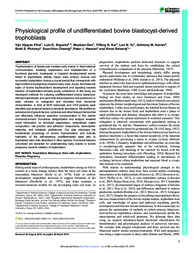Physiological profile of undifferentiated bovine blastocyst-derived trophoblasts.
Physiological profile of undifferentiated bovine blastocyst-derived trophoblasts.
Author(s): PILLAI, V. V.; SIQUEIRA, L. G. B.; DAS, M.; KEI, T. G.; TU, L. N.; HERREN, A. W.; PHINNEY, B. S.; CHEONG, S. H.; HANSEN, P. J.; SELVARAJ, V.
Summary: Trophectoderm of blastocysts mediate early events in fetal-maternal communication, enabling implantation and establishment of a functional placenta. Inadequate or impaired developmental events linked to trophoblasts directly impact early embryo survival and successful implantation during a crucial period that corresponds with high incidence of pregnancy losses in dairy cows. As yet, the molecular basis of bovine trophectoderm development and signaling towards initiation of implantation remains poorly understood. In this study, we developed methods for culturing undifferentiated bovine blastocyst-derived trophoblasts and used both transcriptomics and proteomics in early colonies to categorize and elucidate their functional characteristics. A total of 9270 transcripts and 1418 proteins were identified and analyzed based on absolute abundance. We profiled an extensive list of growth factors, cytokines and other relevant factors that can effectively influence paracrine communication in the uterine microenvironment. Functional categorization and analysis revealed novel information on structural organization, extracellular matrix composition, cell junction and adhesion components, transcription networks, and metabolic preferences. Our data showcase the fundamental physiology of bovine trophectoderm and indicate hallmarks of the self-renewing undifferentiated state akin to trophoblast stem cells described in other species. Functional features uncovered are essential for understanding early events in bovine pregnancy towards initiation of implantation.
Publication year: 2019
Types of publication: Journal article
Unit: Embrapa Dairy Cattle
Keywords: Blastocyst, Embryo implantation, Placenta, Pregnancy, Stem cells, Trophoblast
Observation
Some of Embrapa's publications are published as ePub files. To read them, use or download one of the following free software options to your computer or mobile device. Android: Google Play Books; IOS: iBooks; Windows and Linux: Calibre.
Access other publications
Access the Agricultural Research Database (BDPA) to consult Embrapa's full library collection and records.
Visit Embrapa Bookstore to purchase books and other publications sold by Embrapa.

